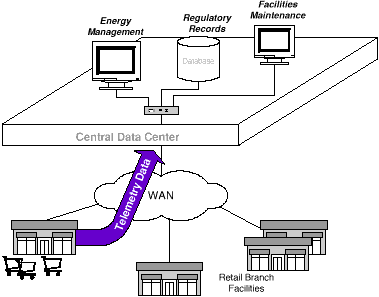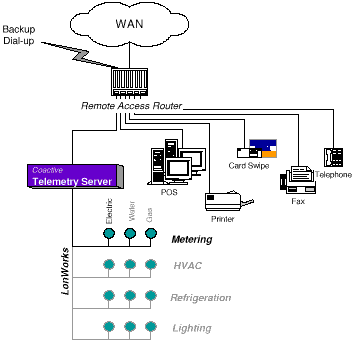![]()
Click on the "Get Acrobat" button to download a FREE copy of Acrobat Reader.
Retail Branch Telemetry
Coactive Division
Broadband Energy Networks Inc.
7000 Terminal Square
Upper Darby PA 19082
Tel: 610.734.1245
Fax: 610.734.1263
Lawrence Silverman, President, Broadband
Energy Networks
Email: lsilverman@broadbandenergynetworks.com
Abstract
Retailers are now beginning to enjoy the power of open networking solutions to reduce costs and improve operations of their geographically distributed enterprises. The ongoing deployment of TCP/IP data networks to link Point-of-Sale (POS) and other in-store systems across a WAN has created a new opportunity to realize additional value from the network and to further improve operations.
Recently developed technology for linking monitoring and control equipment over enterprise networks has given rise to a number of new applications that can deliver substantial value to the Retail business including:
- Energy Usage Monitoring
- Energy Management
- Networked Security Systems
- Automated Regulatory Monitoring
- Fire and Life-safety Monitoring
Energy-related applications are particularly relevant as deregulation of the electric utility industry unfolds across the U.S. and other parts of the world. A better understanding of energy needs enables retailers to negotiate rates and terms and to streamline operations by more effectively managing usage.
These applications are possible by leveraging the data networks being deployed for retail branch stores, along with the open network standards now being used for energy and facility management functions within the store. New connectivity solutions developed by Coactive are making these applications a reality today.
Business Case for Retail Branch Telemetry
The increasingly competitive environment faced by retailers requires that they keep a keen eye toward operating costs and improved efficiency. Emerging telemetry applications such as energy management provide an opportunity to do that while at the same time leveraging the investment being made in wide-area and in-store LAN network infrastructure.
Reducing Energy Costs
Energy accounts for a substantial portion of operating costs of many retailers. Installing accurate metering and sub-metering equipment and linking that equipment into the enterprise WAN allows centralized management and analysis of branch energy usage. By comparing historical usage profiles of similar sites operational inefficiencies can be discovered and corrected. Recent pilot projects have shown that using this type of system inefficiencies can be detected and corrected which result in energy cost savings of 20% or more for a retail site.
As energy industry deregulation moves forward there will be increasing opportunity for retailers to negotiate rates and terms and to manage their consumption to minimize overall costs. In some places utilities are already offering tiered pricing to encourage reduction of demand during “peak” periods. The retailer can take advantage of this by having a better understanding of usage patterns. A telemetry system along with the existing WAN infrastructure can provide this with minimal cost. This approach can be used for electricity, water, and/or gas consumption.

Figure 1 -- Retail Telemetry System
Conforming to Government Regulations (environmental monitoring, food storage)
Public concern over handling and storage methods for commercial food producers and vendors continues to increase. As regulations are enacted and refined to address these concerns retailers and food producers will have to implement efficient systems for maintaining compliance. By linking monitoring devices in the facility into the enterprise WAN, compliance information such as temperature histories and failure events can be recorded and reported automatically.
This same type of system can be used to provide immediate notification of equipment failure so inventories may be saved and corrective action taken to maintain a positive customer experience. Similar monitoring of heating, ventilation, and air conditioning (HVAC) related equipment can be used to ensure that facility air quality standards are maintained.
Reduced Operating Costs via Predictive and Preventative Maintenance
Facility equipment ranging from HVAC to lighting to power backup systems increasingly has intelligence built-in to facilitate preventative maintenance and troubleshooting. Early warning of equipment failure minimizes downtime so that the customer experience is not impacted. Normal maintenance warnings can be routed directly from equipment over the enterprise WAN to facility personnel and directly into maintenance planning and scheduling applications. This allows orderly planning of maintenance activities and optimization of resources. Proper maintenance of facility machinery and systems extends their useful lifespans thereby reducing capital equipment costs.
Remote Supervision of Fire, Life-safety, and Security Systems
Other facility subsystems such as fire and security systems can also be linked into the enterprise WAN providing centralized monitoring and alarm notification. This capability gives the facilities manager better control over the retail branches and can improve safety and security of workers. Policies for these systems can also be set and managed centrally thereby increasing consistency and reducing overall operating costs.
Background and Technical Requirements
The Retail Telemetry System must fit together with existing or planned enterprise WAN solutions. WAN solutions being deployed today are based on open networking standards including Ethernet, Frame Relay, ATM, ISDN. Industry standard TCP/IP is increasingly used both on in-store networks (POS) as well as corporate headquarter sites.
In recent years monitoring and control systems have also adopted open standard networking protocols for connecting devices over low-cost digital networks. For building automation and energy systems the defacto standard is LonWorks. It is now supported by all major vendors of energy and building control systems. It allows equipment such as utility meters, chiller controllers, and lighting from multiple manufactures to communicate over a single twisted-pair network or over existing powerlines. Standards such as LonWorks increase the choice for the building owners and lowers total cost of ownership substantially.
The central requirement of a Retail Telemetry System, if it is to be cost effective, is that it must leverage both the standard retail WAN solution for carrying POS and other business information, as well as existing in-store equipment for metering, HVAC, security and other facility management functions. Retailers are generally moving away from purely dial-up solutions for branch communications and telemetry systems must support the new architectures that utilize Frame Relay and other WAN technologies. In addition to leveraging the network investment and simplifying installation, this approach provides a unified network management solution that lowers total cost of ownership.
Expandability is also an important requirement for a Retail Telemetry System. An initial implementation consisting of only energy measurement will later need to be augmented to include security and regulatory monitoring functions. Telemetry systems that link to these industry-standard control networks, as opposed to those that connect only to single-point devices, allow the greatest flexibility and expandability for the system.
Coactive Products Provide Ideal Retail Branch Solution
Figure 2 below shows a typical telemetry system architecture. The key component in this system is Coactive’s “Telemetry Server” which provides a connection between the devices on the local LonWorks control network and the branch’s in-store LAN. Telemetry information then travels over the same TCP/IP-based WAN used for POS and other store information. Throughput requirements for telemetry data are very low and so the additional load on the network is minimal.
The Telemetry Server is a small low-cost device, much like a network hub or router, which provides the physical connections between the control network (e.g., meters) and the in-store Ethernet LAN. It communicates over the WAN to the various Data Center applications which require telemetry data. It can also be accessed locally from applications or displays in the branch facility (for example to locally view energy usage information). The Telmetry Server has the capability to buffer information and to perform local control logic such as sending alarms when thresholds are exceeded.
The Telemetry Server appears on the LAN as an IP host and supports standard management protocols allowing it to be managed centrally like all other in-store networking equipment.
The Telemetry Server can also provide optional interfaces to legacy devices via serial or other connections. This allows a smooth migration from current generation equipment to newer intelligent networked control devices now being deployed.

Figure 2 -- Telemetry Architecture at Retail Branch
Conclusions and Recommendations
A new generation of retail branch telemetry applications are possible that can help retailers be more competitive in their operations by reducing energy costs. These systems can also provide better management of facilities and help automate regulatory monitoring and other functions.
Coactive Networks offers solutions today to implement retail telemetry systems that fit seamlessly with existing and new WAN infrastructures as well as with in-store metering and other equipment. These solutions are simple to install, low in cost and ensure a minimal total cost of ownership.
With rapidly unfolding changes such as energy deregulation, it is important that retailers act now to lay the groundwork for the competitive environment of tomorrow.